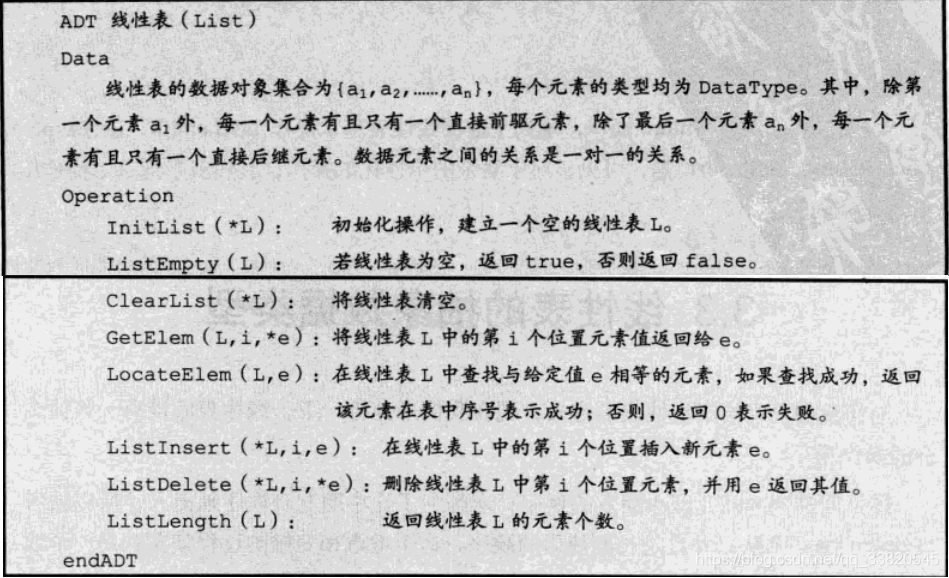2019.10.10
【数据结构-线性表的顺序结构】
基本操作:初始化,判断是否空表,清空表,获取表中的第i个元素,查找元素,插入元素,删除元素,获取表的元素个数。
抽象数据类型:

#include <stdio.h>
#include<malloc.h>
#include<stdlib.h>
#include<string.h>//数据结构-线性表的顺序表示和实现#define TRUE 1
#define FALSE 0
#define OK 1
#define ERROR 0#define MAXSIZE 100 //定义线性表的最大长度typedef int Status; //Status是函数的类型,其值是函数的结果状态码
typedef int ElemType; //顺序表存储元素类型,考虑到可移植性,若改变存储类型,只需要修改这一处,默认为int类型typedef struct MyStruct
{ElemType data[MAXSIZE]; //存储空间地址int length; //当前长度
}List;//初始化操作,建立一个空的线性表
Status InitList(List &L);//打印线性表的所有元素
void PrintList(List L);//若线性表为空,则返回true,否则返回false
bool ListEmpty(List L);//将线性表清空
Status ClearList(List &L);//将线性表中地i个元素值返回给e
ElemType GetElem(List L, ElemType i, ElemType *e);//在线性表中查找与给定值e相等的元素,如果查找成功,返回该元素在表中的序号表示成功;否则,返回0表示失败
int LocateElem(List L, ElemType e);//在线性表第i个位置插入新元素e
bool InsertList(List &L, ElemType i, ElemType e);//删除线性表中第i个元素,并用e返回其值
Status ListDelete(List &L, ElemType i, ElemType &e);//返回线性表L的元素的个数
int ListLength(List L);int main() {List list1, list2;//初始化ListInitList(list1);//判断list是否为空if (ListEmpty(list1)){printf("该线性表为空\n");}else {printf("该线性表不为空\n");}//给线性表插入元素printf("给线性表插入元素...");InsertList(list1, 1, 1);InsertList(list1, 2, 2);InsertList(list1, 3, 3);//打印线性表中的元素PrintList(list1);//查找1在线性表中的序号printf("整数1在线性表中的序号: %d\n", LocateElem(list1, 1));//返回线性表中的元素个数printf("list1线性表中元素个数为:%d\n", ListLength(list1));//删除线性表中的元素int num;ListDelete(list1, 1, num);//打印线性表中的元素PrintList(list1);//返回线性表中的元素个数printf("list1线性表中元素个数为:%d\n", ListLength(list1));system("pause");return 0;
}//初始化操作,建立一个空的线性表
Status InitList(List &L) {L.length = 0;return OK;
}//打印线性表的所有元素
void PrintList(List L){if (L.data == NULL) {exit(0);}printf("该线性表的元素为: ");for (int i = 0; i < L.length ; i++){printf("%d ", L.data[i]);}printf("\n");
}//若线性表为空,则返回true,否则返回false
bool ListEmpty(List L){if (L.data == NULL){return false;}else{return true;}
}//将线性表清空
Status ClearList(List &L){if (L.data != NULL){free(L.data);}return OK;
}//将线性表中地i个元素值返回给e
ElemType GetElem(List L, ElemType i, ElemType *e){if (i<0 && i>L.length){ //输入的i有误return ERROR;}*e = L.data[i - 1];return OK;
}//在线性表中查找与给定值e相等的元素,如果查找成功,返回该元素在表中的序号表示成功;否则,返回0表示失败
int LocateElem(List L, ElemType e){for (int i = 0; i < L.length; i++){if (L.data[i] == e) {return i + 1; //注意:返回的是该元素在线性表的序号,并非下标!}else{return 0;}}
}//在线性表第i个位置插入新元素e
bool InsertList(List &L, int i, ElemType e)
{if (i<1 || i>L.length + 1) //判断i的范围是否有效{printf("位置无效!\n");return false;}if (L.length >= MAXSIZE) //当前存储空间已满,不能插入{printf("当前存储空间已满!!!\n");return false;}//表中最后一个元素的下标是length-1,再后一位是length for (int j = L.length; j >= i; j--)L.data[j] = L.data[j - 1];L.data[i - 1] = e; //在位置i处放入eL.length++; //线性表长度加1return true;
}//删除线性表中第i个元素,并用e返回其值
Status ListDelete(List &L, ElemType i, ElemType &e){if (i<0 || i>L.length){ //输入的序号错误!return ERROR;}e = L.data[i - 1]; //将被删除的元素赋值给e,通过e返回其值for (int j = i; j <= L.length - 1; j++) {L.data[j - 1] = L.data[j];}L.length--;return OK;
}//返回线性表L的元素的个数
int ListLength(List L){return L.length;
}









)






,2.哈希表法,目前更新了枚举法)


